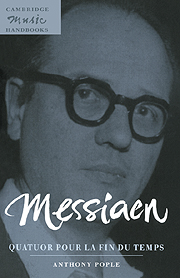Book contents
- Frontmatter
- Contents
- Acknowledgements
- Introduction
- 1 ‘Liturgie de cristal’
- 2 ‘Vocalise, pour l'Ange qui annonce la fin du Temps’
- 3 ‘Abîme des oiseaux’
- 4 ‘Intermède’
- 5 ‘Louange à l'Éternité de Jésus’
- 6 ‘Danse de la fureur, pour les sept trompettes’
- 7 ‘Fouillis d'arcs-en-ciel, pour l'Ange qui annonce la fin du temps’
- 8 ‘Louange à l'Immortalité de Jésus’
- 9 Contexts
- Appendix: Messiaen's modes à transpositions limitées
- Notes
- Select bibliography
- Index
6 - ‘Danse de la fureur, pour les sept trompettes’
Published online by Cambridge University Press: 05 June 2012
- Frontmatter
- Contents
- Acknowledgements
- Introduction
- 1 ‘Liturgie de cristal’
- 2 ‘Vocalise, pour l'Ange qui annonce la fin du Temps’
- 3 ‘Abîme des oiseaux’
- 4 ‘Intermède’
- 5 ‘Louange à l'Éternité de Jésus’
- 6 ‘Danse de la fureur, pour les sept trompettes’
- 7 ‘Fouillis d'arcs-en-ciel, pour l'Ange qui annonce la fin du temps’
- 8 ‘Louange à l'Immortalité de Jésus’
- 9 Contexts
- Appendix: Messiaen's modes à transpositions limitées
- Notes
- Select bibliography
- Index
Summary
Rhythmically the most characteristic piece of the set. The four instruments in unison are made to sound like gongs and trumpets (the first six trumpets of the apocalypse followed by various catastrophes, the trumpet of the seventh angel announcing the consummation of the mystery of God). The use of added values, augmented or diminished rhythms, and non-retrogradable rhythms. Music of stone, fearful granite sonorities; the irresistible movement of steel, enormous blocks of purple fury, of icy intoxication. Listen above all to the terrible fortissimo of the theme in augmentation and the changes in register of its different notes, towards the end of the piece.
In this ‘dance of frenzy’, there is no harmony to soften the impact of the vigorous melody: all four instruments play the same line throughout – the piano in bare octaves and the others doubling as best they can. Only in the climactic passage near the end (vi/O:1 ff.) is this limitation briefly transcended as the full range of the piano is brought into play. Although Messiaen likens the extraordinary sonority of the four instruments in unison to the sound of gongs and the seven biblical trumpets, he perhaps wisely does not attempt to provide musical parallels to the ‘various catastrophes’ they announce. Instead, the powerful tension of the instrumental unison is presented as an analogue of these almost inconceivable events of judgement.
There is a residual parallel nonetheless between the musical form and those passages of Revelation in which the sound of the trumpets is described.
- Type
- Chapter
- Information
- Messiaen: Quatuor pour la fin du temps , pp. 64 - 71Publisher: Cambridge University PressPrint publication year: 1998



